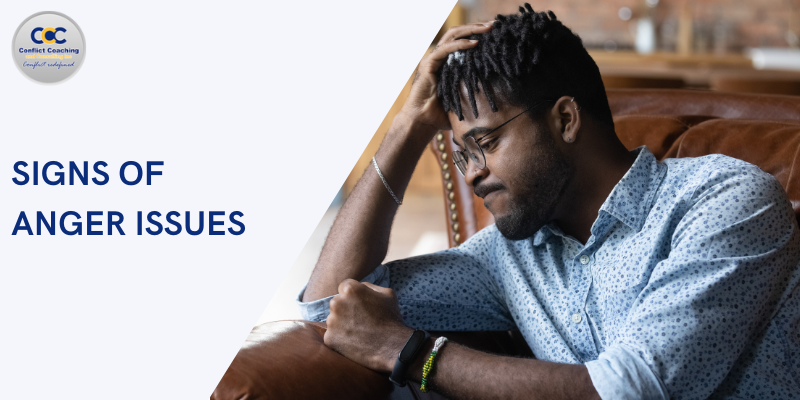
Passive Aggressive Anger: Causes, Symptoms & Examples
Anger is a complex emotion that can manifest in various ways, and passive-aggressive anger is one of its intriguing forms.
Unlike the more direct and overt expressions of anger, passive-aggressive anger involves subtle and indirect behaviors, making it challenging to identify and address.
Passive aggressive anger can be a frustrating experience for both the person expressing it and those on the receiving end.
It often involves hiding true feelings, veiled sarcasm, intentional procrastination, or withholding communication to express displeasure indirectly.
This blog will delve into passive-aggressive anger and explore its impact on individuals and their connections with others.
We will shed light on the underlying anger issues, causes, signs, and potential consequences of this unique expression of anger.
Understanding passive-aggressive anger is crucial for fostering healthier communication and finding constructive ways to manage emotions.
Join us on this insightful journey as we unravel the complexities of passive-aggressive anger and work towards building healthier and more authentic connections with others.
What is Passive Aggressive Anger?

Passive-aggressive anger is a unique form of expressing displeasure, where individuals resort to indirect, subtle, or disguised behaviors to convey their frustration or hostility.
Unlike overt aggression, passive-aggressive anger masks hostility behind a facade of compliance or indifference, making it challenging to recognize and address.
This type of anger can manifest in various situations, from personal relationships to professional settings, causing confusion and frustration for those on the receiving end.
Passive-aggressive individuals may use sarcasm, procrastination, forgetfulness, or deliberate inefficiency to express their anger indirectly.
They may appear cooperative on the surface but harbor negative feelings beneath, causing tension and affecting their relationships.
Over time, passive-aggressive behavior can erode trust and communication, making it crucial to understand and address this issue effectively.
Here we are diving into the intricacies of passive-aggressive anger, exploring its impact on individuals and relationships.
By shedding light on passive-aggressive anger, we aim to foster healthier communication and promote more harmonious connections in various aspects of life.
How Common Is Passive Aggressive Anger in Today’s World?
Passive-aggressive anger is more common than one might think, and its prevalence is found in various interpersonal and professional settings.
While overt aggression is easier to identify, passive-aggressive behavior can be subtle, making it challenging to estimate its actual occurrence accurately.
Many individuals resort to this form of expression to cope with their anger and frustration, often stemming from a fear of confrontation or a desire to avoid direct conflict.
In today’s world, where stress and pressures are prevalent, passive-aggressive behavior can be a coping mechanism for some people.
The competitive nature of workplaces and the complexities of personal relationships can contribute to the emergence of passive-aggressive anger as a response to perceived challenges or injustices.
Moreover, the rise of digital communication platforms and social media can exacerbate passive-aggressive tendencies, as people may use passive-aggressive language or actions online to express their dissatisfaction without directly confronting others.
Understanding the prevalence of passive-aggressive anger is essential for fostering healthier communication and addressing underlying issues fueling such behavior.
By recognizing the signs and causes of anger, individuals can take proactive steps to address this type of anger constructively and build more harmonious personal and professional relationships.
What Are the Causes of Passive Aggressive Anger?
The causes of passive-aggressive anger are multifaceted and can vary from person to person.
While some individuals may resort to this behavior due to underlying psychological issues, others might develop passive-aggressive tendencies as a learned response to particular environments or past experiences. Some common causes of passive-aggressive anger include:
- Fear of Confrontation: People with passive-aggressive tendencies may fear direct confrontation or the potential negative consequences of expressing their anger openly. Instead, they choose indirect ways to communicate their dissatisfaction or disagreement.
- Childhood Learned Behavior: Passive-aggressive behavior can be learned in childhood as a coping mechanism for dealing with authoritarian or controlling caregivers. If a child is discouraged from expressing anger directly, they might internalize this approach into adulthood.
- Low Self-Esteem: Individuals with low self-esteem may struggle to assert themselves and express their needs openly. Instead, they resort to passive-aggressive tactics to indirectly communicate their frustrations.
- Avoiding Conflict: Passive-aggressive behavior can also be a way of avoiding direct conflict in relationships. It may be used to maintain harmony on the surface while expressing anger or resentment covertly.
- Power Struggles: In some cases, passive-aggressive behavior can respond to perceived power struggles or a way to gain control when a person feels powerless.
- Emotional Suppression: If someone has difficulty identifying or expressing their emotions, they may resort to passive-aggressive behavior to indirectly release pent-up anger.
Understanding the underlying causes of passive-aggressive anger is crucial for effectively addressing and managing this behavior.
By recognizing these triggers, individuals can work on developing healthier communication skills and finding more constructive ways to express their emotions.
What Are the Signs and Symptoms of Passive Aggressive Anger?
Recognizing passive-aggressive anger can be challenging as it involves subtle and indirect behaviors.
The signs and symptoms of passive-aggressive anger may manifest in various ways and can include:
- Sarcasm and Backhanded Compliments: Passive-aggressive individuals often use sarcasm or give backhanded compliments to disguise their true feelings or criticisms.
- Procrastination and Avoidance: They may intentionally procrastinate on tasks or avoid responsibilities to express their anger indirectly.
- Silent Treatment: Passive-aggressive individuals might give silent treatment or refuse to communicate openly when upset, causing relationship tension.
- Indirect Criticism: Instead of openly expressing dissatisfaction, they may criticize others indirectly or make veiled negative remarks.
- Sabotaging Others: Passive-aggressive individuals may subtly sabotage others’ plans or efforts without directly confronting the issue.
- Agreeing but Not Following Through: They might agree to do something but deliberately not follow through on their promises or commitments.
- Playing the Victim: Passive-aggressive individuals may act like victims, portraying themselves as unfairly treated while withholding their anger.
- Hostility Disguised as Helpfulness: They may appear helpful on the surface but use their actions to express resentment or annoyance.
- Stubbornness and Resistance: Passive-aggressive individuals may resist suggestions or change to express their displeasure.
- Blaming Others: They may blame others for their negative feelings or circumstances rather than taking responsibility for their emotions.
Recognizing these signs can help individuals address and manage their passive-aggressive behavior effectively.
Open communication, self-awareness, and learning healthier ways to express emotions are essential for overcoming passive-aggressive tendencies and building healthier relationships.
How Can Passive Aggressive Anger Affect You?
Passive-aggressive anger can harm physical and mental health due to the chronic stress and unresolved emotions it creates.
Physical Health

The continuous internalization of anger and resentment associated with passive-aggressive behavior can increase stress levels, manifesting in physical symptoms such as headaches, muscle tension, digestive issues, and a weakened immune system.
Prolonged stress can also contribute to developing chronic conditions like hypertension, heart problems, and other stress-related ailments.
Mental Health

Living with unresolved anger and engaging in passive-aggressive behavior can negatively impact one’s mental health.
Individuals may experience increased feelings of anxiety, depression, and irritability. This suppressed anger can also lead to powerlessness and frustration, affecting self-esteem and overall emotional well-being.
Moreover, passive-aggressive behavior can strain interpersonal relationships, leading to social isolation and loneliness.
Addressing passive-aggressive anger is crucial for preserving both physical and mental health. By seeking healthier ways to express emotions, individuals can prevent the adverse consequences of passive-aggressive behavior on their overall well-being.
Example of Passive Aggressive Anger
Passive-aggressive behavior manifests as a way to express anger indirectly, often avoiding open communication about the underlying issues.
Example 1
Sarah and John have been assigned to work on a project together. However, Sarah feels resentful towards John for not contributing enough effort.
Instead of addressing her concerns directly, Sarah intentionally delays responding to John’s emails.
She conveniently forgets to share important information with him. Her passive-aggressive behavior undermines the project’s progress and creates tension between them.
Example 2
Mike and Lisa are roommates, and Lisa is annoyed with Mike’s habit of leaving dirty dishes in the sink.
Instead of confronting him directly, Lisa uses passive-aggressive notes around the house, hinting at the importance of cleanliness and tidiness without addressing the issue directly.
This indirect approach leads to increased frustration and a strained living situation.
Example 3
Susan has been asked to attend a family gathering she isn’t particularly interested in attending.
Instead of expressing her feelings honestly, Susan agrees to go but intentionally arrives late, making everyone wait for her.
She also uses short and sarcastic responses throughout the event to convey her displeasure without directly voicing her discontent.
This type of behavior can lead to misunderstandings, strained relationships, and unresolved conflicts, ultimately affecting one’s emotional well-being and social interactions.
10 Tips To Manage Passive Aggressive Anger
Passive-aggressive anger can be challenging to navigate as it involves indirect expressions of frustration and dissatisfaction.
To effectively manage this type of anger, developing healthy coping strategies that allow for assertive communication and emotional release is essential. Some of these tips are listed as follows:
- Recognize behavioral anger patterns
- Practice self-awareness
- Utilize relaxation techniques
- Practice deep breathing exercises
- Take a time-out
- Engage in physical activities to release tension
- Communicate assertively and calmly
- Seek support from friends, family, or professionals
- Enroll in a course
- Engage in regular stress-reducing activities
By incorporating these tips into your daily life, you can effectively manage passive-aggressive anger and cultivate healthier ways of expressing yourself and managing conflicts.
1. Recognize Passive Aggressive Anger Patterns
Recognizing anger patterns is a crucial step in managing passive-aggressive anger. Passive-aggressive individuals may not overtly express their anger but exhibit subtle behaviors that reflect their frustration or dissatisfaction.
These patterns can include using sarcasm, procrastination, giving backhanded compliments, or deliberately avoiding tasks or responsibilities.
By becoming aware of these behaviors, you can identify your anger triggers and gain insight into the underlying emotions driving your passive-aggressive reactions.
Once you recognize these patterns, you can work towards adopting healthier coping mechanisms and addressing conflicts more directly.
Self-awareness is crucial in breaking the cycle of passive-aggressive behavior and developing healthier communication styles.
As you become more in tune with your emotional responses, you can consciously express yourself more assertively and constructively.
2. Practice Self-Awareness

Self-awareness is an essential aspect of managing passive-aggressive anger. It involves understanding your emotions, thoughts, and reactions to different situations.
By cultivating self-awareness, you can recognize when you resort to passive-aggressive behavior and explore the root causes of your anger.
This introspection allows you to gain better control of your anger and make conscious choices about expressing your feelings.
Practicing self-awareness also involves being mindful of your body’s physical responses to stress or frustration.
By paying attention to physical cues like tensed muscles or increased heart rate, you can identify when you’re feeling angry and take steps to manage your emotions effectively.
3. Utilize Relaxation Techniques

Relaxation techniques can be invaluable tools for managing your emotions when dealing with passive-aggressive anger.
Engaging in activities like meditation, progressive muscle relaxation, or guided imagery can help reduce feelings of tension and promote emotional stability.
These techniques encourage you to focus on the present moment and let go of negative emotions, preventing them from escalating into passive-aggressive behaviors.
By incorporating relaxation techniques into your daily routine, you can cultivate a sense of calm and resilience, making it easier to navigate challenging situations with assertiveness and composure.
As you practice these techniques regularly, you’ll develop the ability to remain more composed and grounded in the face of stressors and triggers.
4. Practice Deep Breathing Exercises

Deep breathing exercises are simple yet effective tools for managing passive-aggressive anger.
When confronted with triggering situations, taking slow, deep breaths can activate the body’s relaxation response, easing tension and promoting emotional balance.
Focusing on your breath creates a pause between the trigger and your response, allowing for a more thoughtful and measured reaction.
These breathing exercises can be practiced discreetly in any setting, making them accessible tools for managing passive-aggressive anger in various situations.
As you practice deep breathing regularly, you’ll develop the capacity to remain more composed and respond assertively to challenging circumstances.
5. Take a Time-Out
When passive-aggressive anger builds up, taking a time-out can be a valuable strategy to regain emotional equilibrium.
Stepping away from the situation or conversation lets you cool down and gain perspective.
During this break, reflect on your feelings and consider how you want to address the issue constructively.
A time-out is not about avoiding conflicts or suppressing emotions but about creating a space for self-reflection and gathering your thoughts.
When you feel calmer, you can return to the conversation more composed and assertive, fostering open communication and understanding.
6. Engage in Physical Activities

Physical activities offer an excellent outlet for releasing pent-up tension and frustration associated with passive-aggressive anger.
Regular exercise, such as walking, jogging, cycling, or participating in a fitness class, can help reduce stress hormones and improve overall well-being.
Physical activity and anger management classes help control anger and contribute to better mental health, as it releases endorphins, which are natural mood lifters.
Incorporating regular physical activity into your routine can boost your emotional resilience and enhance your ability to cope with stressful situations without resorting to passive-aggressive behaviors.
7. Communicate Assertively and Calmly
One of the key strategies for managing passive-aggressive anger is learning to communicate assertively and calmly. This involves expressing your feelings and needs directly and clearly without resorting to sarcasm or veiled hostility.
Passive-aggressive individuals often struggle to express their anger openly, leading to indirect or covert expressions of frustration.
By developing assertive communication skills, you can effectively communicate your boundaries, concerns, and needs, fostering open and honest dialogue in your relationships.
Practice using “I” statements to express your feelings and avoid blaming or accusing others.
This approach allows you to address conflicts clearly and respectfully, reducing the likelihood of misunderstandings and resentment.
8. Seek Support from Friends, Family, or Professionals

Dealing with passive-aggressive anger can be challenging, and seeking support from loved ones or professionals can provide valuable insights and guidance.
Talking to someone you trust about your feelings and struggles can offer a fresh perspective on your behavior and help you work towards constructive solutions.
Consider confiding in friends, family members, or mentors who can provide non-judgmental support and encouragement.
Alternatively, seeking the assistance of a therapist or counselor can offer a safe space to explore the underlying causes of your passive-aggressive anger and develop coping strategies for healthier emotional expression.
9. Enroll in a Course
Enrolling in an anger management course can be an empowering step toward understanding and managing passive-aggressive anger.
These courses offer guidance, support, and practical strategies to recognize triggers, enhance self-awareness, and adopt healthier coping mechanisms.
Participating in structured programs allows you to learn alongside others facing similar challenges, creating a sense of community and shared experiences.
The course provides tools and techniques to communicate assertively and manage conflicts constructively, fostering healthier relationships and emotional well-being.
10. Engage in Regular Stress-Reducing Activities

Engaging in regular stress-reducing activities complements your efforts to manage passive-aggressive anger effectively.
Pursue hobbies or activities that bring you joy and help you relax, such as reading, painting, gardening, or spending time in nature.
By dedicating time to stress-reducing activities, you create a positive and rejuvenating outlet for emotions, preventing them from manifesting in passive-aggressive behaviors.
Regularly engaging in stress-reducing activities can promote emotional balance and well-being.
Frequently Asked Questions (faqs)
Is silent treatment passive-aggressive?
Yes, silent treatment is a common example of passive-aggressive anger, where an individual uses silence to express anger, frustration, or displeasure without directly communicating their feelings.
How do you act passive-aggressive?
Passive-aggressive behavior can manifest through indirect and subtle actions, such as sarcasm, procrastination, forgetfulness, or intentionally withholding information to express anger or frustration.
What is passive-aggressive body language?
Passive-aggressive body language may include:
- Avoiding eye contact.
- Giving fake smiles.
- Crossing arms.
- Other non-verbal cues convey resistance or hostility while appearing outwardly compliant.
Conclusion
Passive aggressive anger is a complex and challenging emotion that can significantly affect individuals and their relationships.
It often arises as a coping mechanism for those who struggle to express their anger directly, leading to indirect and covert behaviors that may cause confusion and distress for others.
Recognizing and addressing passive-aggressive anger is crucial for fostering healthier communication and maintaining positive connections with those around us.
By developing self-awareness and understanding the root causes of our anger, we can choose healthier and more constructive ways to express ourselves.
At Mastering Anger, we understand the importance of managing anger healthily and assertively. Our anger management courses provide valuable insights, tools, and techniques to help individuals navigate and overcome their anger challenges.
You can learn to manage your emotions and cultivate healthier relationships through our expert guidance and support.
Don’t let passive-aggressive anger control your life and hinder your well-being. Take the first step towards managing your anger by enrolling in our Mastering Anger courses today.
Together, we can help you achieve emotional balance and develop healthy coping strategies for a brighter future.





Responses